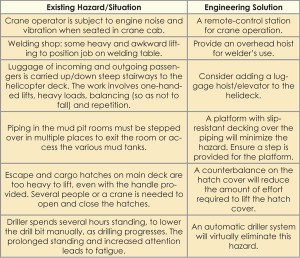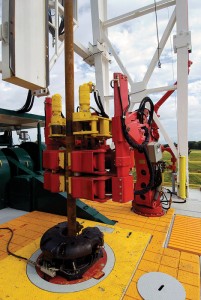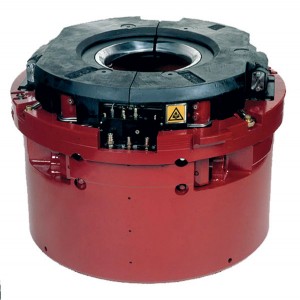Training, hazard control key to better ergonomics
Automation, collaborative plan help put rig crews out of harm’s way to prevent MSDs
By Angelo Pinheiro, Marathon Oil Corp, and Ben D. Cranor, Texas A&M University – Commerce

Musculoskeletal disorders (MSDs) are a significant source of economic loss to drilling companies. It is difficult to pinpoint the extent of MSDs in the industry as: a) there are few published studies, b) MSD injuries and illnesses are not separately accounted for in accident statistics and c) the cost of related injuries, illnesses and work disruptions is not clearly known. However, MSDs have been and continue to be an occupational risk factor, as illustrated by these studies:
• 47% of injuries in the Norwegian offshore petroleum sector were related to MSDs. Of those, 20% were back injuries, 53% were upper limb disorders and 16% were lower limb disorders.
• The National Academy of Sciences estimates MSDs cost between $45 billion and $54 billion in 1999. The costs would be significantly higher today.
• Recent field research indicates ergonomic issues that lead to MSDs are abundant in the oil and gas industry.
These statistics indicate that MSDs are a source of significant economic loss and highlight the need for more formal management. This article describes and discusses the components of a basic ergonomics program for an oil and gas drilling operation.
Ergonomic program design

A ergonomics program should not be a standalone effort but should be managed within the Occupational Health and Safety Management System (OHSMS). Drilling and service contractors are advised to use this information with caution and to consider hiring a certified ergonomist. An article in the March/April 2001 issue of Drilling Contractor (p22) provides guidance on selecting an ergonomics consultant.
An ergonomics program should include:
• Management leadership and employee participation;
• Hazard information and reporting;
• Job hazard analysis and control;
• Training;
• MSD management; and
• Program evaluation.
Management leadership and employee participation

Participatory ergonomics, where management and employees cooperate to reduce the incidence of MSDs, has been growing. Management commitment and leadership can be demonstrated by:
• Formulating and championing polices aimed at MSD prevention;
• Sanctioning human and financial resources required for ergonomic program implementation;
• Establishing objectives, goals and metrics for the program;
• Defining roles and responsibilities, and holding leaders accountable for program implementation;
• Making STOP WORK an employee responsibility when situations could cause/exacerbate an MSD;
• Including ergonomics in rig design and specifications, “Management of Change” reviews and safety inspections;
• Establishing an ergonomics program committee and meeting with employees to discuss the issues and solutions; and
• Requiring periodic program reviews/audits and ensuring corrective actions.
Opportunities for employee participation in the ergonomic program include:
• Active involvement in the ergonomics program committee;
• Participation in the development of policy, processes and procedures;
• Involvement in ergonomic hazard identification and risk assessments;
• Participation in ergonomic surveys and workplace inspections and tests;
• Evaluation and selection of personal protective equipment (PPE); and
• Participation in MSD incident investigation.
Hazard information and reporting

Ergonomic hazard assessment involves gathering and assessing data for MSD. Such information may be provided by:
• Injury and workers compensation reports and treatment logs (written consent from the employee must be obtained);
• MSD symptom surveys and previous ergonomic studies;
• Employee reports of ergonomic hazards, such as repetitive and/or forceful lifting and handling, cramped working conditions requiring awkward postures, back bending, high arm forces, vibration, contact stress, fatigue due to prolonged standing or sitting, etc;
• Jobs identified during risk assessments that have the potential for strains, fatigue, pain and discomfort because of physical workloads and repetitive tasks. Those jobs are also the most frequently reported cause of employee complaints in the offshore petroleum industry;
• Modification requests (to rig layout, systems, processes, equipment, etc) that could impose or increase the MSD risks;
• Well drilling and well service programs, where inadequate consideration to schedules could impose MSD risks;
• Purchase and maintenance records for hand and power tools (e.g., pipe wrenches and pipe tongs) that point to frequent replacement or service requests;
• Industry newsletters, safety alerts and studies, and information published by agencies and associations, such as the Human Factors and Ergonomics Society and the Association of Canadian Ergonomists;
• Employee job descriptions. The majority of drilling jobs involve MSD risks. Three such positions that can be singled out are the floorhand, derrickhand and roustabout. Those positions involve repeated lifting, lowering, pushing, pulling, carrying and a high degree of attention for prolonged periods. These jobs must often be performed under harsh conditions, which can increase the risk of injury or aggravate an existing condition.
Job hazard analysis and control

After information has been compiled on the ergonomic hazards, a job hazard analysis should be performed to assess the risks, qualitatively and quantitatively. Several methods are available for ergonomic hazard assessment, including:
• Washington State, Appendix B Criteria for Analyzing and Reducing MSD Hazards. This technique is suitable to analyze jobs that involve awkward postures; high hand force; highly repetitive motion; repeated impact; heavy, frequent or awkward lifting; and hand-arm vibration.
• ACGIH Hand-Arm Segmental Vibration (HAV). The procedure for measuring HAV is provided in the ACGIH TLV and BEI booklet, along with guidance on the desirable exposure levels.
• Snook Tables are based on the psychophysical methodology, which combines heart rate, oxygen consumption and anthropometric (body dimensions) measurements with feelings of exertion or fatigue to estimate the male and female population that can safely carry out jobs involving lifting, lowering, pushing, pulling and/or carrying. Published by Liberty Mutual (Manual Material Handling Guidelines), these tables are useful for drilling ergonomic hazard assessments.
• The revised NIOSH Lifting Equation combines biomechanical, physiological and psychophysical criteria to determine the recommended weight load (RWL) for jobs involving two-handed manual lifting. It starts with a load constant of 51 lbs (23 kg), which is adjusted downward by reach, distance, asymmetry, frequency and coupling multipliers to determine the RWL. The lifting index is then determined to understand the magnitude of physical stress for the job. This method cannot be used for:
o Lifting/lowering with one hand;
o Lifting/lowering for more than 8 hrs;
o Lifting/lowering while seated or kneeling;
o Lifting/lowering in a restricted work space;
o Lifting/lowering unstable objects;
o Lifting/lowering while carrying, pushing or pulling;
o Lifting/lowering with wheelbarrows or shovels;
o Lifting/lowering with high-speed motion (faster than about 30 in./sec);
o Lifting/lowering with unreasonable foot/floor coupling (less than 0.4 coefficient of friction between the sole and the floor);
o Lifting/lowering in an unfavorable environment (i.e., temperature outside the 66-79°F range and relative humidity outside the 35% to 50% range).
• Posture, Activity, Tools and Handling (PATH). The PATH method is suitable for jobs that are non-repetitive and non-cyclic (or have irregular cycles). PATH takes into account work postures, worker activity, tool use, loads handled and grasp type.
Job hazard analyses should be performed by specialists who are trained in ergonomic evaluations since it involves operations analysis, time studies, occurrence sampling, measurements (of the workstation, tools, working environment, body dimensions, physiology, etc), employee interviews, work observations and documentation reviews.
Ergonomic hazard control methods

The selection of controls for MSD should follow the three-tier hierarchy recommended by OSHA: engineering controls, administrative controls and PPE.
Engineering controls
Engineering controls are based on the principle of designing the hazard out of the job (elimination), and when that cannot be achieved, enclosing the hazard, substituting it with safer alternatives, or modifying the equipment or working arrangements. Examples where engineering controls can be used to reduce ergonomic hazards on a drilling rig are shown in Table 1.
Technological advances have made possible the automation of high MSD-risk tasks such as making and breaking pipe joints and moving pipe from the catwalk to the rig floor and vice versa. Some of these are illustrated in Figures 1 to 5.
Administrative controls
Administrative-type controls should be used in combination with engineering controls. Examples of administrative controls for drilling rig applications are:
• Work procedures and job safety analyses that address MSD hazards and risks;
• Training employees to recognize MSD risk factors and their prevention and treatment;
• Job rotation of personnel in jobs with high physical demands to less stressful jobs;
• Housekeeping to ensure that walking and working surfaces are clean and free of clutter, oil/grease, water, etc. This will ensure good traction for lifting tasks;
• Planned maintenance system for equipment, tools, floor surfaces, etc; and
• Purchasing controls that specify ergonomic standards in purchase and work orders.
Personal protective equipment controls
PPE is the last line of defense, as a malfunction would immediately expose the employee to the hazard. PPE should be used only to augment engineering and administrative controls. They should be comfortable to wear, provide the desired protection and not add to the hazard. PPE should be designed, inspected and maintained to the required standard, manufacturer recommendations and regulatory requirements. PPE aspects with respect to MSD prevention include:
• Work boots with ankle protection;
• Anti-vibration gloves for use with impact and pneumatic tools (needle guns, impact wrenches, sledge hammers, etc);
• Gloves that provide the required protection, dexterity and grip;
• Insulated PPE and boot drying racks for work in cold and wet environments;
• Back belts offer no real protection and do not change the employee’s perception of the physical demands of the task; hence their use is not encouraged;
• Boot scrapers to ensure that the soles are clear of debris, oil, etc.
Training
The successful implementation of an ergonomics program calls for the participation of personnel. Each staff level has specific roles and responsibilities under the program, and they should be trained to carry out those responsibilities. NIOSH (1997) recommends a three-level training program for ergonomics that includes:
• Ergonomics awareness training;
• Training in job analyses and control measures; and
• Training in problem solving.
Ergonomics awareness training
Ergonomics awareness training should be provided to all employees and may include these topics:
• Recognizing and controlling MSD risk factors;
• Signs and symptoms of MSD onset;
• Procedures to report an issue;
• Company ergonomics program;
• Roles and responsibilities under the program;
• Measures the company has taken to reduce MSD; and
• Regulatory requirements.
Training in job hazard analyses and control
Training in job hazard analysis and control is required for employees involved in the development of job safety analysis and standard operating procedures, review of modification/change requests, health and safety committee, and those involved in recommending or implementing the recommendations from job hazard analyses. The following topics are typically addressed:
• MSD risk assessment methodologies and criteria;
• Hierarchy of controls; and
• Corrective action tracking system.
Training in problem solving
Training in ergonomics problem solving is the highest level of training and requires completion of awareness training. Job hazards and control training are pre-requisites. Training is intended for personnel involved in resolving MSD risk factors and should be provided by a certified ergonomist. Training should include:
• Hazard identification methods commonly used in the industry;
• Qualitative and quantitative risk assessment methodologies;
• Cost-benefit analysis;
• A review of the technologies available for MSD reduction;
• Team-building, consensus development and problem-solving techniques;
• Risk communication.
MSD management
MSD management addresses prevention and treatment. Prevention pertains to identifying and controlling risk factors through the use of hazard assessment techniques and engineering, administrative and PPE controls. The treatment aspects pertain to post-injury medical treatment, rehabilitation and reintegration into the work force. Those responsibilities fall on management, employees and healthcare providers (HCPs).
Employer responsibilities
Management is further responsible for familiarizing the HCP with workplace hazards, sanctioning workplace modifications and making reasonable accommodations for employees returning to work with functional limitations.
Employee responsibilities
Employees who have been diagnosed with MSD are further responsible for following the HCP’s advice with respect to medical treatment, physiotherapy, counseling and functional restrictions.
Healthcare provider responsibilities
An HCP should be appointed for the diagnosis and treatment of MSDs. The HCP must understand the physiological, psychological and environmental parameters and constraints that pertain to the employee’s work. HCP responsibilities include:
• Familiarizing with company policies, systems and processes, and the work activities and conditions under which they are performed;
• Advising and guiding the medic on treatment and care of MSDs;
• Participating in ergonomic hazard evaluations; and
• For “at-risk” employees: a) reviewing their medical histories, b) assessing MSD factors, c) conducting initial, annual and post-injury assessments, d) providing a written opinion of the employee’s medical condition with respect to the job activities, risk factors and MSD factors, e) recommending time off work or work restrictions, f) specifying the functional capacity limitations and recommendations for workplace or work modification, and g) informing the employee of the results of the medical assessment;
• Liaison with the worker’s compensation insurance provider, injured employee’s personal physician and agency officials (if required); and
• Maintaining the confidentiality and privacy of information and records.
Early reporting and access to healthcare providers
Provisions should be made to enable the early reporting of MSD symptoms to the HCP so that case management can promptly begin. Early diagnosis and treatment of MSD symptoms has been proven to reduce the severity of the condition.
Program evaluation
An evaluation of the ergonomics program should be performed at least annually. The evaluation should be performed by an individual who is familiar with the program but not directly involved in its development or implementation. The program evaluation should:
• Verify that requirements have been implemented;
• Evaluate the effectiveness of controls following interventions to correct MSD hazards;
• Comment on the metrics and actual performance results;
• Evaluate the ergonomics awareness of employees, their understanding of reporting mechanisms and their satisfaction with the actions taken to correct hazards; and
• Recommend specific control measures to correct any identified gaps.
Conclusion
MSDs impose major operating costs on employers in the drilling industry. An ergonomics program that is a subset of the occupational health and safety management system would provide a vehicle to anticipate, recognize, evaluate and control MSD risks.
Angelo Pinheiro is project HES advisor – upstream developments for Marathon Oil Corp, and Dr Ben Cranor is assistant professor at the Department of Engineering & Technology at Texas A&M University – Commerce.
Authors’ note: The recommendations and ideas expressed in this article are those of the authors and do not necessarily represent the views of Marathon Oil Company, its directors, parent company, affiliates, subsidiaries, executives, shareholders or employees.
References
Ciriello, Vincent M. (2008). Does wearing a no-expanding weight lifting belt change psychophysically determined maximum acceptable weight and forces. International Journal of Industrial Ergonomics, 38 (11-12), 1045-1050.
Dixon, Shane M., Theberge, Nancy, and Cole, Donald C. (2009). The case of participatory ergonomics. Industrial Relations, 64 (1), 50-74.
IADC (2011). Incident statistics program: 2022 Reporting guidelines. IADC.
Jensen, Carsen & Jensen, Chris (2006). Ergonomic exposure assessment of an offshore drilling rig. Forskningsenheden For Maritim Medicin, No. 12, November 2006. Research University of Maritime Medicine, University of Southern Denmark.
Hansen, Mark, D. (2001). Key questions help choose ergonomics consultant. Drilling Contractor¸ March 2001. IADC.
Konz, Stephan & Johnson, Steven (2008). Chapter 29: Managing an ergonomics program. Work Design: Occupational Ergonomics, 7th Ed., pp.541-545. Holcomb Hathaway.
Laing, A. C., Cole, D. C., Theberge, N., Wells, R. P., Kerr, M. S. & Frazer, M. B. (2007). Effectiveness of a participatory ergonomics intervention in improving communication and psychosocial exposures. Ergonomics, 50 (7), 1092-1109.
McGowan, B. (2011). Simple ergonomic assessment tools and design guidelines for the oil, gas, and petrochemical industries. American Industrial Hygiene Association, 2011 Conference and Exhibition, Portland, OR.
Morken, Tone, Mehlum, Ingrid Sivesind, & Moen, Bente E. (2007). Work-related musculoskeletal disorders in Norway’s offshore petroleum industry. Occupational Medicine 2007, 57, 112-117.
NAS (2001). Chapter 2: Dimensions of the problem. Musculoskeletal Disorders and the Workplace, pp.38-64. National Academy of Sciences.
NIOSH (1997). Elements of ergonomics programs. DHHS (NIOSH) Publication No. 97-117, National Institute of Occupational Safety and Health, Cincinnati, OH.
Plog, Barbara A., Niland, Jill & Quinlan, Patricia (1996). Chapter 13: Ergonomics. Fundamentals of Industrial Hygiene, 4th Ed., pp. 347-402. National Safety Council,
Waters, Thomas R., Putz-Anderson, Vern & Garg, Arun (1994). Application manual for the revised NIOSH lifting equation. DHHS (NIOSH) Publication No. 94-110




